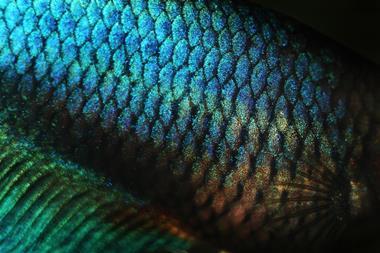Epoxy sponge that registers heavy knocks could alert doctors to head injuries in soliders and athletes
Diagnosing concussion is a difficult task, but scientists in the US have designed a tool that can highlight a potential injury with a polymer-based patch that changes colour depending on the level of impact. It is hoped the material could be integrated into protective headgear for athletes or soldiers.
Intense scrutiny is being levelled at sports organisations over the lack of protection that athletes have to defend them from a severe head injury. Although the safety culture is beginning to change in sports such as American football, medical professionals still face the difficult prospect of diagnosing a suspected concussion quickly in the high pressure environment of a sporting arena or stadium.
For Shu Yang from the University of Pennsylvania, the blurred line in diagnosing concussion raises an unsettling question both for researchers and doctors, who may not be sure whether a patient has suffered an injury. ‘To what extent should players or soldiers [be allowed to] go back to the battlefield or the playfield?’ Yang asked when speaking at the 250th ACS National Meeting & Exposition in Boston, US, this week.

Her concerns led her to seek a solution to the concussion diagnosis conundrum. Yang, along with colleagues at Villanova and Temple University, looked to structural colours in nature for ideas. ‘We take inspiration from opal, which is made from silica beads,’ says Yang. She goes on to explain that such materials take on particular colours depending on their internal microstructure, and changes in this structure can alter how light is diffracted.
But producing analogous crystals in the lab is incredibly expensive, so the team turned to flexible polymers instead. Yang and her colleagues used a light-sensitive epoxy named SU-8, melted it and poured it over a crystalline arrangement of opals. Once the polymer had cooled and solidified, the opals were removed to produce a porous polymer network resembling a sponge.
‘Light coming towards this porous material gets reflected,’ says Yang. ‘It’s like the colour you see in iridescence in [a] soap bubble.’ The pores are acting as ‘inverse opals’, according to Yang.
By applying a force roughly equivalent to a typical football tackle using nanoindentation, Yang was able to see the porous patch changed colour. ‘If you have external force hitting this porous material, the pore size [and] shape will be changed,’ she explains. ‘So, this … will cause a structural change, [which] causes a colour change.’
Crucially this colour change is not reversed when the force is removed, making it ideal for protective equipment. ‘Once you remove the force, the material is permanently deformed,’ says Yang. It can also be tuned to accommodate for different coloured surfaces: ‘If we started with different nanoparticles, we can generate different initial colours, whether it’s a red, orange, green or purple.’
Yang acknowledges, however, that a commercial product may still be a long way off, but she is glad that technology will help in tackling the concussion issue head on. ‘There [are] a lot of things we need to do,’ she says. ‘From a protective point of view, at least we can use this to tell people what’s going on.’












No comments yet